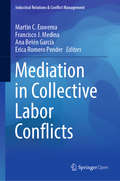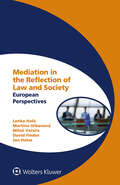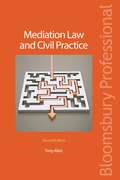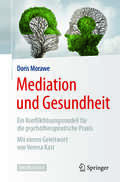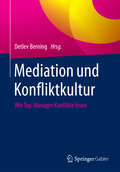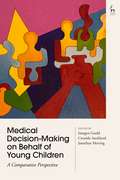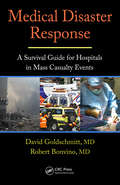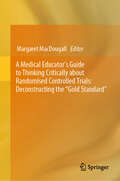- Table View
- List View
Mediation in Collective Labor Conflicts (Industrial Relations & Conflict Management)
by Ana Belén García Martin C. Euwema Francisco J. Medina Erica Romero PenderThis open access book opens up the black box of mediation in collective conflicts through the analyses and comparisons of various systems. Mediation and related third party interventions such as conciliation and facilitation are discussed as effective prevention and regulation tools for different types of collective labor conflicts. These interventions fit in a new developed five-phase model of collective conflicts in organizations, going from capacity building in latent conflicts, through conciliation, mediation and arbitration in escalating phases, to rebuilding of trust after hot conflicts. The authors promote understanding and discussion with regards to labor mediation systems, presenting comparative research on the perspectives of mediators and users of mediation. This book describes and analyses laws, regulations and practices of mediation in seventeen countries, with a relative strong emphasis on Europe. Part 1 presents theoretical frameworks on conciliation and mediation in collective labor conflicts. Part 2 presents regulations and practices in 12 European countries: Belgium, Denmark, Estonia, France, Italy, Poland, Portugal, Spain, The Netherlands, and the United Kingdom. Part 3 discusses mediation in these collective conflicts in Australia, China, India, South Africa and the USA. Part 4 offers conclusions and ways forward. This book offers analyses, good practices and developments for third party intervention in collective labor conflicts in global and local changing environments. This book is a must-read for policy makers, , social partners at different levels, as well as scholars and practitioners in industrial relations, human resources management and conflict management, particularly conciliators and mediators.
Mediation in Family Disputes: Principles of Practice
by Marian RobertsThis is the authoritative textbook on family mediation. As well as mediators, this work will be indispensable for practitioners and scholars across a wide range of fields, including social work and law. It draws on a wide cross-disciplinary theoretical literature and on the author's extensive and continuing practice experience. It encompasses developments in policy, research and practice in the UK and beyond. Roberts presents mediation as an aid to joint decision-making in the context of a range of family disputes, notably those involving children. Mediation is seen as a process of intervention distinct from legal, social work and therapeutic practice, drawing on a distinctive body of knowledge across disciplinary fields including anthropology, psychology and negotiation theory. Incorporating empirical evidence, the book emphasises the value of mediation in mitigating the harmful effects of family breakdown and conflict. First published in 1988 as a pioneering work, this fourth edition has been fully updated to incorporate legal and policy developments in the UK and in Europe, new sociological and philosophical perspectives on respect, justice and conflict, and international research and practice innovations.
Mediation in Family Disputes: Principles of Practice
by Marian RobertsThis is the authoritative textbook on family mediation. As well as mediators, this work will be indispensable for practitioners and scholars across a wide range of fields, including social work and law. It draws on a wide cross-disciplinary theoretical literature and on the author's extensive and continuing practice experience. It encompasses developments in policy, research and practice in the UK and beyond. Roberts presents mediation as an aid to joint decision-making in the context of a range of family disputes, notably those involving children. Mediation is seen as a process of intervention distinct from legal, social work and therapeutic practice, drawing on a distinctive body of knowledge across disciplinary fields including anthropology, psychology and negotiation theory. Incorporating empirical evidence, the book emphasises the value of mediation in mitigating the harmful effects of family breakdown and conflict. First published in 1988 as a pioneering work, this fourth edition has been fully updated to incorporate legal and policy developments in the UK and in Europe, new sociological and philosophical perspectives on respect, justice and conflict, and international research and practice innovations.
Mediation in International Commercial and Investment Disputes
by Catharine Titi and Katia Fach GómezUntil now, the resolution of international commercial and investment disputes has been dominated almost exclusively by international arbitration. But that is changing. Whilst they may be complementary mechanisms, international mediation and conciliation are now coming to the fore. Mediation rules that were in disuse gather momentum, and dispute settlement centres are introducing new mediation rules. The European Union is encouraging international mediation in both the commercial and investment spheres. The 2019 Singapore Mediation Convention of the United Nations Commission on International Trade Law (UNCITRAL) is aiming to ensure enforcement of international commercial settlement agreements resulting from mediation. The first investor-State disputes are mediated under the International Bar Association (IBA) rules. The International Centre for Settlement of Investment Disputes (ICSID)'s conciliation mechanism is resorted to more often than in the past. The International Chamber of Commerce (ICC) has recently administered its first mediation case based on a bilateral investment treaty, and a new training market on mediation is flourishing. Mediation in Commercial and Investment Disputes brings together a line-up of outstanding, highly-qualified experts from academia, mediation and arbitration institutions, and international legal practice, to address this highly topical, complex subject from a variety of angles.
Mediation in International Commercial and Investment Disputes
Until now, the resolution of international commercial and investment disputes has been dominated almost exclusively by international arbitration. But that is changing. Whilst they may be complementary mechanisms, international mediation and conciliation are now coming to the fore. Mediation rules that were in disuse gather momentum, and dispute settlement centres are introducing new mediation rules. The European Union is encouraging international mediation in both the commercial and investment spheres. The 2019 Singapore Mediation Convention of the United Nations Commission on International Trade Law (UNCITRAL) is aiming to ensure enforcement of international commercial settlement agreements resulting from mediation. The first investor-State disputes are mediated under the International Bar Association (IBA) rules. The International Centre for Settlement of Investment Disputes (ICSID)'s conciliation mechanism is resorted to more often than in the past. The International Chamber of Commerce (ICC) has recently administered its first mediation case based on a bilateral investment treaty, and a new training market on mediation is flourishing. Mediation in Commercial and Investment Disputes brings together a line-up of outstanding, highly-qualified experts from academia, mediation and arbitration institutions, and international legal practice, to address this highly topical, complex subject from a variety of angles.
Mediation in Political Conflicts: Soft Power or Counter Culture? (Oñati International Series in Law and Society)
by Jacques FagetThis book provides a vivid reader on experiences of mediation throughout history and in many different regional, cultural and legal contexts. For experts in the field of mediation and legal anthropology it provides a series of fascinating case studies not previously reported on. For those not familiar with the field it provides a window on an alternative possibility for peacemaking in political conflicts. The book is held together by the editor's introduction, which defines political mediation, the research methodologies employed, the relationship of mediation to participatory democracy, and the growth of mediation in the past twenty years. The chapters which follow provide the anatomy of successful and unsuccessful mediations in contexts as widely diverse as the 30 Years War (1618-1648) which was ended following the intercession of the future Pope, Alexander VII. Three further chapters examine the role of the Catholic Church in other mediations - in the Basque conflict, in Burundi and in Chiapas, while a further group of chapters looks at conflicts in Ethiopia, Northern Ireland, Central America and Congo.
Mediation in the Reflection of Law and Society: European Perspectives (Global Trends in Dispute Resolution Series)
by Lenka Holá Miloš Večeřa Martina Urbanová Jan Holas David FiedorDespite slow progress in use, mediation continues to consolidate its presence in dispute resolution. This important book argues that a more favourable socio-legal climate must be created for mediation to thrive, and accordingly analyses the legal, cultural, social, systemic and spatial aspects of the use of mediation in the legal practice of the different countries of the European Union (EU). Based on a spatiotemporal analysis and models of mediation in the EU, it pinpoints the social and cultural reasons for the fragmentation of its legal regulation and shows what paths are available to promote the effective implementation of mediation in social practice. It is the first book to capture the socio-legal context of mediation. A spatiotemporal analysis of the extent of use of mediation in a region as large and at the same time as diverse as the EU has never been carried out before. Using various methodological and conceptual approaches to analyse the legal and social aspects of introducing mediation to legal systems, the authors – all with long-term experience in the exercise and research of mediation directly in the field – provide invaluable insights into such facets of the use of mediation as the following: the social context that raises the need for mediation; obstacles to the wider use of mediation in resolving disputes between parties; the effects of social influences reflected in legislation that shape the laws of each country; the basic models that make up the system of access to mediation in specific EU Member States; the role of law as a tool for social change and its reflection in the legal regulation of mediation; and perspectives for further development of mediation in the EU. The legislative efforts proposed to enhance the regulation of mediation in EU countries are based on modern knowledge of law, sociology and psychology. As a unique combination of exploration of the theoretical determinants of mediation and an empirical study of the extent of its use in the European area, this book’s fundamental contribution to the legal theory and practice of mediation is inarguable. Its analysis of mediation from three perspectives – as a means of improving citizens’ access to justice, as a means of applying social justice in society, and as a means of restorative justice – are of the utmost value in today’s global society. For users of mediation, EU institutions involved in mediation, EU Member State authorities addressing the issue of mediation, and the wider dispute resolution community worldwide, the book will be welcomed for the giant steps it takes toward refining arguments for the promotion of mediation and its development, in theory, research and practice.
Mediation Law: A Guide To The Law In Ireland
by Penelope McRedmondIn September 2017 the Government passed the Mediation Act 2017. This Act sets out a statutory framework integrating mediation into the Irish civil justice system. The 2017 Act aims to promote mediation as a viable, effective and efficient alternative to court proceedings, thereby reducing legal costs, speeding up the resolution of disputes and reducing the stress and acrimony that often accompanies court proceedings.This new title focuses on the 2017 Act and takes the reader through it section by section, analysing the meaning and impact of each. In addition this is the first book in Ireland to draw together the law from many different disciplines and apply them to mediation. The relevance of the law of contract to mediation and the law relevant to family law mediations are particularly highlighted.The book also examines the law relevant to mediation in the context of the fundamental principles of mediation. The voluntary nature of mediation, the self determination of the parties, the neutrality and impartiality of the mediator and particularly the importance of confidentiality in the mediation process are therefore all explained in relation to the legal issues that arise as a consequence of their relevance to the mediation process.The book enables the reader to understand the relationship between the Mediation Act and the civil justice system with a detailed look at the relevant Rules of Court their interaction with the Act and application by the Courts.In European Union law the impact of the Directive on certain aspects of mediation in civil and commercial matters 2008 is referenced throughout the book. The book also examines a number of statutory procedures that fall outside the Mediation Act, giving a convenient, easily assessable description of the mediation processes under the following:· Workplace Relations Act 2015· The Residential Tenancies Act 2004· The Disability Act 2005· The Multi-Unit Developments Act 2011· The Civil Liability and Courts Act 2004· The Financial and Pensions Ombudsman Act 2017
Mediation Law and Civil Practice
by Mr Tony Allen'Here you have all you need to know and more… this textbook will become the ADR bible. I unreservedly recommend it.' The Rt Hon Sir Alan Ward*Mediation Law and Civil Practice examines the position of mediation within the civil justice system in England and Wales, providing an essential read for mediators, mediation providers, lawyers, judges, academics and students. The book traces the evolution of the relationship between the courts and mediation, discussing all the significant judgments relating to mediation over the last 30 years as well as exploring the key concepts at the heart of mediation and all the latest developments.The Third Edition:- Discusses the impact of Churchill v Merthyr Tydfil and the consequent CPR changes in force as from 1 October 2024 on mediation and civil justice in England & Wales- Includes new content on: - The latest Ministry of Justice initiatives in promoting mediation - The differences between mediation and neutral evaluation- Mediator ethics - The future of mediation in English civil justice - Provides an update on proposed reforms to the Pre-Action Protocols over requiring use of mediation- Fully updated caselaw, including significant post-Churchill decisions such as Northamber v Genee World; Heyes v Holt; and Invenia v Hudson- A review of how mediation has become integrated into civil practice over the last 35 years and the relationship between mediation, academic theory, statute, caselaw and court rules The book also challenges the status quo by casting doubt on some decisions and generates alternative thinking around current law and practice.This title is included in Bloomsbury Professional's Mediation online service.*From the Foreword to the 1st edition
Mediation Law and Civil Practice
by Tony AllenMediation Law and Civil Practice examines the position of mediation within the civil justice system in England and Wales. It explains and challenges current thinking about mediation, identifying ways for the government and judiciary to improve the delivery of justice through greater trust in the process.It traces the evolution of the relationship between the courts and mediation, discussing all the significant judgments relating to mediation over the last 25 years as well as exploring the key concepts at the heart of mediation and all the latest developments. Mediation Law and Civil Practice also challenges the status quo by casting doubt on some decisions and generates alternative thinking around current legal and practice concepts.As well as updating all case law, the second edition also:- discusses the attitudes generated by the Jackson Review and also the Briggs reforms proposed in the Chancery Modernisation Review and his Court Structure Review- discusses AB v CD, in which a mediator has now given evidence in an English court and Global and related cases on varying “whole agreement” clauses- enlarges the discussion of protocols, which have been modified and remain inconsistent in their treatment of ADR- analyses the EU Consumer Directive - sets out the reforms to CPR Part 36Mediators, mediation providers, lawyers, judges academics and students will all benefit from the expert commentary and in-depth analysis in this book. It is also a useful guide for academics and mediation providers outside of the UK who are seeking to influence the development of mediation in their jurisdictions.
The Mediation Process: Practical Strategies for Resolving Conflict
by Christopher W. MooreThe Fourth Edition of a seminal work in the field of mediation and conflict resolution For almost thirty years, conflict resolution practitioners, faculty, and students have depended on The Mediation Process as the all-inclusive guide to the discipline. The most comprehensive book written on mediation, this text is perfect for new and experienced conflict managers working in any area of dispute resolution—family, community, employment, business, environmental, public policy multicultural, or international. This is the expert's guide, and the Fourth Edition has been expanded and revised to keep pace with developments in the field. It includes new resources that will promote excellence in mediation and help disputants reach durable agreements and enhance their working relationships. Includes expanded information on the latest approaches for providing mediation assistance Features comprehensive guidelines for selecting the right strategy for both common and unique problems Utilizes updated, contemporary case studies of all types of disputes Offers expanded coverage of the growing field and practice of intercultural and international mediation
The Mediation Process: Practical Strategies for Resolving Conflict
by Christopher W. MooreThe Fourth Edition of a seminal work in the field of mediation and conflict resolution For almost thirty years, conflict resolution practitioners, faculty, and students have depended on The Mediation Process as the all-inclusive guide to the discipline. The most comprehensive book written on mediation, this text is perfect for new and experienced conflict managers working in any area of dispute resolution—family, community, employment, business, environmental, public policy multicultural, or international. This is the expert's guide, and the Fourth Edition has been expanded and revised to keep pace with developments in the field. It includes new resources that will promote excellence in mediation and help disputants reach durable agreements and enhance their working relationships. Includes expanded information on the latest approaches for providing mediation assistance Features comprehensive guidelines for selecting the right strategy for both common and unique problems Utilizes updated, contemporary case studies of all types of disputes Offers expanded coverage of the growing field and practice of intercultural and international mediation
Mediation Skills and Strategies: A Practical Guide
by Tony WhatlingA concise text that offers a straightforward, comprehensive collection of mediator skills and strategies. Combines hands on advice, theory and practical examples for novice and experienced mediators.
Mediation und Gesundheit: Ein Konfliktlösungsmodell für die psychotherapeutische Praxis
by Doris Morawe Verena KastDieses Buch zeigt Fachleuten, die z. B. Patienten oder Klienten bei deren Konflikten begleiten und beraten, wie sie das Verfahren der Mediation nutzen können. Grundtenor ist die sich in unseren Köpfen erst langsam festigende Erkenntnis, dass ungelöste, verdeckte und lange quälende Konflikte, ebenso wie das Erleben von Ohnmacht und fehlender Autonomie "krank" machen. Dabei bietet der Fokus auf den Interessensausgleich ein einfaches Modell, das sich gut in andere Settings integrieren lässt. Wie das geht, beschreibt die Autorin, und sie verdeutlicht das durch zahlreiche Praxisbeispiele.Geschrieben für Psychotherapeuten, Berater, Ärzte, aber auch Interessierte anderer Berufsgruppen, die in ihren Berufsfeldern mit Konflikten konstruktiv umgehen wollen, z. B. Führungskräfte, Rechtsanwälte, Richter, Steuerberater, Supervisoren, Trainer, Pädagogen, Sozialpädagogen, Architekten, Verwaltungsangestellte.Aus dem Inhalt Grundlagen – Abgrenzung Mediation und Therapie – 5 Phasen des Mediationsmodells – Anwendung in der Praxis.
Mediation und Konfliktkultur: Wie Top-Manager Konflikte lösen
by Detlev BerningDieses Buch untersucht interdisziplinär die Erfolgsfaktoren für Wirtschaftsmediation. Rechtsanwalt und Mediator Dr. iur. Detlev Berning hat renommierte Vertreter aus Wirtschaft, Politik und Wissenschaft eingeladen, Einblick zu geben in die jeweilige Konfliktkultur ihrer Bereiche und in ihre Erfahrungen mit Mediation. Im Fokus steht dabei die Frage, unter welchen Voraussetzungen Mediation Erfolg haben kann, welchen Veränderungen Organisationen sich stellen (müssen) und welche Entwicklungen in Zukunft zu erwarten sind. Zudem wird diskutiert, inwiefern Mediation in Unternehmen und anderen Organisationen zu „guter Führung“ beitragen kann.Mit Interviews und Fachbeiträgen von Prof. Patrick Sensburg (Mitglied des Deutschen Bundestages), Prof. Claude-Hélène Mayer (Universität Frankfurt/Oder), Dr. Gerhard Stamer (Universität Bamberg), Dr. Antje von Dewitz (Vaude), Martin Kind (Kind Hörgeräte) sowie Vorständen, Aufsichtsräten und anderen Top-Managern.
Medical and Psychological Effects of Concentration Camps on Holocaust Survivors
by Robert KrellThis unique research bibliography is offered in honor of Leo Eitinger of Oslo, Norway. Dr. Eitinger fled to Norway in 1939, at the start of the World War II. He was caught and deported to Auschwitz, where, among others, he operated on Elie Wiesel who has written the foreword to this volume. After the war, Eitinger became a pioneering researcher on a subject from which many shied away. His contributions to understanding of the experience of massive psychological trauma have inspired others to do similar work. His many books and papers are listed in this special volume of the acclaimed bibliographic series edited by Israel W. Charny of The Institute on the Holocaust and Genocide in Jerusalem.In order to acquaint users of this bibliography with the topic, two introductory articles are offered. The first is titled "Survivors and Their Families" and deals with the impact of the Holocaust on individuals. The second, "Psychiatry and the Holocaust," examines the general impact of the Holocaust on the field of psychiatry. Robert Krell writes that in general the psychiatric literature has reflected critically on the survivor due to preconceived notions held by many mental health professionals. For many years, the exploration of victims' psychopathology obscured the remarkable adaptation made by some survivors. The problems experienced by survivors and possible approaches to treatment were entirely absent from mainstream psychiatric textbooks such as the Comprehensive Textbook of Psychiatry throughout the 1960s and 1970s.Fifty years of observations about survivors of the concentration camps and other survivors of the Holocaust (in hiding, as partisans, in slave labor camps) has provided a new body of medical and psychiatric literature. This comprehensive bibliography contains a plethora of references to significant pieces of literature regarding the Holocaust and its effects on survivors. It will be of inestimable value to physicians, psychiatrists, psychologists, and social workers, along with historians, sociologists, and Holocaust studies specialists.
Medical and Psychological Effects of Concentration Camps on Holocaust Survivors
by Robert Krell & Marc I. ShermanThis unique research bibliography is offered in honor of Leo Eitinger of Oslo, Norway. Dr. Eitinger fled to Norway in 1939, at the start of the World War II. He was caught and deported to Auschwitz, where, among others, he operated on Elie Wiesel who has written the foreword to this volume. After the war, Eitinger became a pioneering researcher on a subject from which many shied away. His contributions to understanding of the experience of massive psychological trauma have inspired others to do similar work. His many books and papers are listed in this special volume of the acclaimed bibliographic series edited by Israel W. Charny of The Institute on the Holocaust and Genocide in Jerusalem.In order to acquaint users of this bibliography with the topic, two introductory articles are offered. The first is titled "Survivors and Their Families" and deals with the impact of the Holocaust on individuals. The second, "Psychiatry and the Holocaust," examines the general impact of the Holocaust on the field of psychiatry. Robert Krell writes that in general the psychiatric literature has reflected critically on the survivor due to preconceived notions held by many mental health professionals. For many years, the exploration of victims' psychopathology obscured the remarkable adaptation made by some survivors. The problems experienced by survivors and possible approaches to treatment were entirely absent from mainstream psychiatric textbooks such as the Comprehensive Textbook of Psychiatry throughout the 1960s and 1970s.Fifty years of observations about survivors of the concentration camps and other survivors of the Holocaust (in hiding, as partisans, in slave labor camps) has provided a new body of medical and psychiatric literature. This comprehensive bibliography contains a plethora of references to significant pieces of literature regarding the Holocaust and its effects on survivors. It will be of inestimable value to physicians, psychiatrists, psychologists, and social workers, along with historians, sociologists, and Holocaust studies specialists.
Medical Assistance in Dying: Key Multidisciplinary Perspectives (The International Library of Bioethics #104)
by Jaro Kotalik David W. ShannonThis book, written both for a Canadian and an international readership, provides a multidisciplinary review of the framework and performance of the Canadian Medical Assistance in Dying (MAID) program. In the first five years (2015-2021) of operation, this program delivered voluntary euthanasia and assistance in suicide to over 30,000 Canadian residents, presently representing a 30% annual growth. Looking back on these first five years, the 30 Canadian scholars and clinicians contributing to this volume raise important issues and attempt to answer key questions that have arisen in regards to its operation and its stated objectives. This volume strikes the most appropriate balance between the autonomy of persons who seek medical assistance, versus the interests and protection of vulnerable persons. Finally, the book makes suggestions on how the program can presently be improved. It identifies gaps in knowledge about MAID’s operational program and its impact on individuals, families and society in order to stimulate the necessary research that is essential to the evolution of a healthy and well-balanced program. As a first, comprehensive examination of medically assisted deaths in Canada, this publication will be of great value to lay, professional, academic, political audiences both domestically and internationally, especially in jurisdictions that are examining their options of permitting assisted deaths.
Medical Benefit and the Human Lottery: An Egalitarian Approach to Patient Selection (International Library of Ethics, Law, and the New Medicine #22)
by Duff R. WaringBioethicists, moral philosophers and social policy analysts have long debated about how we should decide who shall be saved with scarce, lifesaving resources when not all can be saved. It is often claimed that it is fairer to save younger persons and that age is an ethically relevant consideration in such tragic decisions. Medical benefit should be maximized and final selection should aim to minimize the contaminating influence of chance. These claims are challenged by Duff R. Waring in Medical Benefit and the Human Lottery, one of the few books that attempts a sustained defence of random patient selection. This book combines ethics and political philosophy in its novel and strict egalitarian approach to patient selection for transplantable organs. Waring addresses the question of whether we should choose between lives on the basis of fair chances or best outcomes. He argues that final selection criteria should be based on fair chances that equalize opportunity as opposed to best outcomes. His defence of "hardy" egalitarianism aims to show that random selection by lottery can affirm both a common humanity and the equal value of lives. The notion of patient selection by lottery has not fared well in bioethics and has been regarded by some as a moral affront. Waring argues that a human selection lottery may be neither as crude nor as ethically anomalous as some have supposed. Indeed, it can reflect a familiar conception of equality as a political and moral ideal. This conception abstracts from many undeniable differences between patients and claims that scarce resources should be allocated on the principled assumption that each of their lives is equally worth saving. The book is also notable for its critiques of some recent utilitarian notions of medical benefit which can have an age-biased impact on elderly patients. Waring then argues against the leading, contemporary age-based approaches to patient selection. He explores the way random selection by lottery can affirm his egalitarian ethos in cases where eligible transplant candidates have each passed a threshold level of prospective medical benefit that has been set by democratic deliberation. Taming chance with a human lottery is defended as the most lucid means of ensuring equal opportunity. In so doing, Waring argues that we give the principle of equal concern and respect a radical expression: above a noncomparative threshold of medical benefit, each candidate can have an equal claim to life.
Medical Challenges for the New Millennium: An Interdisciplinary Task
by SusannaElm Stefan N. WillichIn 1978, the World Health Organization (WHO) designated the year 2000 as the "due date" for world health. The Alma Ata declaration set the turn of the century as the target for a level of health that would permit all people of the world to lead a socially and economically productive life. ' At that (magic but arbitrary) date most infectious diseases and many chronic conditions, including diabetes and cancer, were expected to have been eradicated or at least controlled. Such predictions were based on solid foundations. In the 1 20 h century, and particularly since the 1970's, Western science and technology based (or "modern") medicine has made quantum leaps in numerous areas as diverse as pharmacology, genetic and molecular biology, surgical techniques, infertility treatments, and pre- and neo-natal care. This impressive trajectory of progress, which continues unabatedly, gave every reason to assume that come the year 2000 humanity would finally be free from many of its ancient scourges. However, as we are all too well aware, the new millennium witnesses also ever more terrifying threats to our health as a result of the emergence of 2 AIDS in the early 80's, the resurgence of infectious diseases such as 3 tuberculosis and malaria, now drug resistant, the absence of significant breakthroughs in the treatment of cancer and cardiovascular diseases, and the continuing dramatic gap in health care between industrialized and developing countries, to mention but a few examples.
Medical Decision-Making on Behalf of Young Children: A Comparative Perspective
by Imogen Goold, Cressida Auckland and Jonathan HerringIn the wake of the Charlie Gard and Alfie Evans cases, a wide-ranging international conversation was started regarding alternative thresholds for intervention and the different balances that can be made in weighing up the rights and interests of the child, the parent's rights and responsibilities and the role of medical professionals and the courts. This collection provides a comparative perspective on these issues by bringing together analysis from a range of jurisdictions across Europe, North and South America, Africa and Asia. Contextualising the differences and similarities, and drawing out the cultural and social values that inform the approach in different countries, this volume is highly valuable to scholars across jurisdictions, not only to inform their own local debate on how best to navigate such cases, but also to foster inter-jurisdictional debate on the issues. The book brings together commentators from the fields of law, medical ethics, and clinical medicine across the world, actively drawing on the view from the clinic as well as philosophical, legal and sociological perspectives on the crucial question of who should decide about the fate of a child suffering from a serious illness. In doing so, the collection offers comprehensive treatment of the key questions around whether the current best interests approach is still appropriate, and if not, what the alternatives are. It engages head-on with the concerns seen in both the academic and popular literature that there is a need to reconsider the orthodoxy in this area.
Medical Decision-Making on Behalf of Young Children: A Comparative Perspective
In the wake of the Charlie Gard and Alfie Evans cases, a wide-ranging international conversation was started regarding alternative thresholds for intervention and the different balances that can be made in weighing up the rights and interests of the child, the parent's rights and responsibilities and the role of medical professionals and the courts. This collection provides a comparative perspective on these issues by bringing together analysis from a range of jurisdictions across Europe, North and South America, Africa and Asia. Contextualising the differences and similarities, and drawing out the cultural and social values that inform the approach in different countries, this volume is highly valuable to scholars across jurisdictions, not only to inform their own local debate on how best to navigate such cases, but also to foster inter-jurisdictional debate on the issues. The book brings together commentators from the fields of law, medical ethics, and clinical medicine across the world, actively drawing on the view from the clinic as well as philosophical, legal and sociological perspectives on the crucial question of who should decide about the fate of a child suffering from a serious illness. In doing so, the collection offers comprehensive treatment of the key questions around whether the current best interests approach is still appropriate, and if not, what the alternatives are. It engages head-on with the concerns seen in both the academic and popular literature that there is a need to reconsider the orthodoxy in this area.
Medical Decisions, Estrogen and Aging
by Jay SchulkinThe decision making process that underlies ovarian hormone therapy (HT) is fallible. Thus, the decision for women to go on HT remains controversial. At a time when confusion still permeates the decision making with regard to HT, this book bridges diverse features that surround the decision making concerning HT. The book is written for both specialists and generalists in the field.
Medical Disaster Response: A Survival Guide for Hospitals in Mass Casualty Events
by David Goldschmitt Robert BonvinoWhile the job of a clinician in a disaster scenario is to save lives without regard for the cause or rationale for the injury, medical and emergency professionals who understand the diverse aspects of a disaster are better equipped to respond effectively. Giving emergency personnel the tools they need to perform in catastrophic situations, Medical
A Medical Educator's Guide to Thinking Critically about Randomised Controlled Trials: Deconstructing the "Gold Standard"
by Margaret MacDougallDrawing on the statistical and philosophical expertise of its authors, this book is designed to improve understanding and use of randomised controlled trials (RCTs) among health professionals. It is intended for use primarily by medical educators involved in teaching statistics and evidence-based medicine (EBM) to medical students, junior doctors and other health professionals. However, each of the chapters serves a wider range of interests, including the practical needs of physicians in interpreting research evidence to support clinical decision making and the teaching needs of philosophers of medicine who want to more fully appreciate how RCTs work in practice and provide engaging examples for their students. Rather than compete with the proliferating methodological literature on RCT designs, this book focuses on cultivating a healthy skepticism among developing health professionals to support critical appraisal of their own and published work on RCTs at a fundamental level, including through a more informed understanding of the place of subgroup analyses in sound statistical inference. Management of the positive predictive value in the statistical analysis of RCT findings is included as an important topic for contemporary medical curricula. In comparing RCTs with non-randomised studies, a search for empirical evidence for the superiority of RCTs is initiated, pointing to the need for further work to confirm what form this evidence should take.Medical educators will find a wealth of reasons to encourage their students to think more critically about how the RCT operates in practice as a gold standard.
